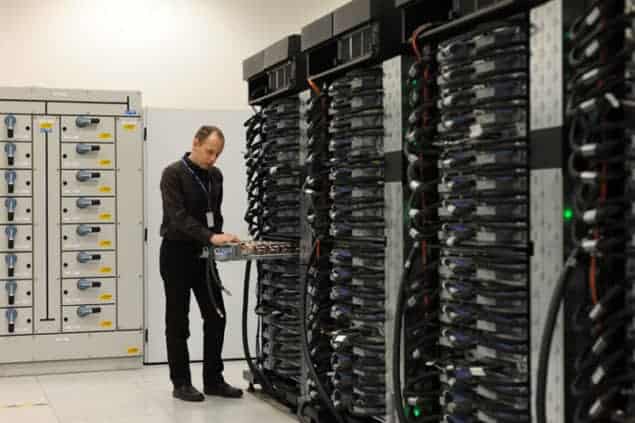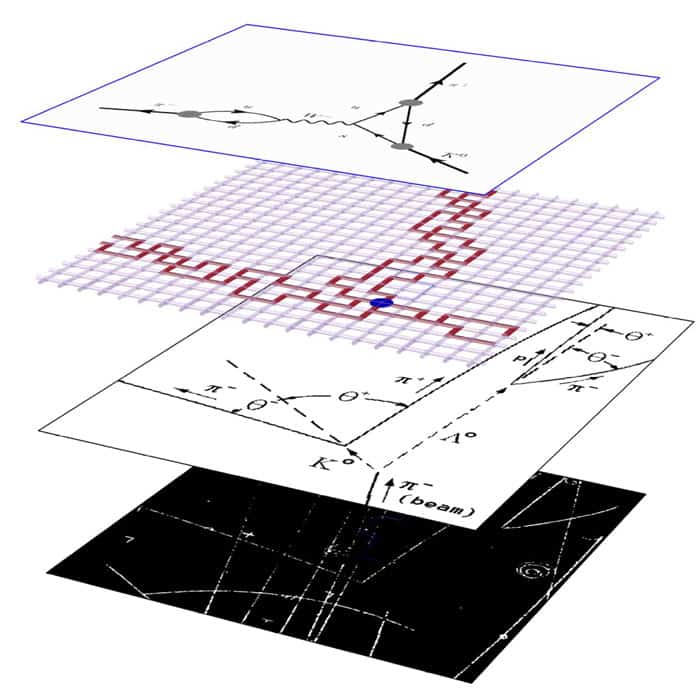
An international team of scientists has, for the first time, simulated the decay process of a kaon into two pions with extreme precision, using some of the fastest supercomputers available today. This calculation could provide further insight into charge–parity (CP) violation and help to explain why there is more matter than antimatter in the universe.
The new work, published this month in Physical Review Letters, involved researchers from the Brookhaven National Laboratory, Columbia University, Washington University and the University of Connecticut in the US; the University of Edinburgh and the University of Southampton in the UK; and the Max-Planck Institute in Germany. The calculation took 54 million processor hours on the IBM BlueGene/P supercomputer at the Argonne National Laboratory in the US.
Violated theories
CP symmetry dictates that a process involving a particle and a process involving the mirror image of its antiparticle should be identical – particles and their antiparticles should decay at exactly the same rate. This is tested either by creating the particles and watching them decay or seeing the process naturally occurring as certain particles decay into their antiparticles.
The kaon decay process has been explored since the 1960s – in fact, it won physicists James Cronin and Val Fitch the 1980 Nobel Prize for Physics for a 1964 experiment where they had set out to prove CP symmetry but instead found the first “indirect” experimental evidence for CP violation as a kaon decayed into two mesons.
Today, the Standard Model of particle physics is the most successful theory that describing how three of the four fundamental forces – the strong, weak and electromagnetic forces, but not gravity – affect subatomic particles. But certain underlying fundamental questions remain unanswered. One way is to test the model at large-scale particle accelerators such as the Large Hadron Collider (LHC) at CERN, Geneva. The other is to look at what one of the team members, physicist Chris Sachrajda from the University of Southampton, calls “rare processes”, which very precisely test predictions of the Standard Model.
Super simulations
When kaons decay into pions, the constituent subparticles – quarks – are affected by the weak force, and as the quarks move apart, they exchange gluons. But one problem is the huge computing power that is required to simulate quark–gluon interactions. “It has taken several decades of theoretical developments and the arrival of very powerful supercomputers to enable physicists to control the interactions of quarks and gluons, the constituents of the elementary particles, with sufficient precision to explore the limits of the Standard Model and to test new theories,” explains Sachrajda. “But we now have the computing power and advanced algorithms that are required to simulate these rare processes.”
In the simulation, a technique known as lattice quantum chromodyamics (QCD) is used to carry out the computation. The parameters of the decay are input into a computer as a finite grid or lattice of space–time points. “Using lattice QCD was tricky, as the lattice box has a finite size and this means that the quarks cannot separate infinitely,” says Sachrajda. He goes on to explain that the process the researchers considered involved the kaon decaying into two mesons with isospin 2 (a quantum number related to the strong interaction). “This isospin has a real and imaginary part – the real part has been predicted and experimentally verified, and our value was in good agreement with that. The imaginary part, on the other hand, is not known from experiment. This is the first time it has been experimentally determined,” explains Sachrajda. He also explains that it was important to repeat this calculation using a second lattice spacing to eliminate any possible errors. The quantum fluctuations of the decay are calculated by a statistical approach called the “Monte Carlo” method, which outputs the most likely fluctuation.
Extreme scales
A novel feature of the computation is that the decay process was simulated over a vast scale. The researchers looked at the process from distances as minute as a 1000th of a femtometre, which allowed them to follow the decay of individual quarks and some other subatomic particles. They also looked at it from a few tenths of a femtometre, where the picture would be obscured by a sea of quark–antiquark pairs and a cloud of the gluons that holds them together. It is at this distance that the gluons begin to bind the quarks into the observed particles. So the actual kaon decay described by the calculation spans distance scales of nearly 18 orders of magnitude – this range is similar to a comparison of the size of a single bacterium and the size of our entire solar system. While the simulation reported here has determined the fundamental kaon decay process, it also marks the beginning of the next phase of the collaboration’s work, which involves improving the precision of the computations and extending the range of physical quantities for which the effects of the strong nuclear force can be quantified. The researchers believe that lattice QCD will continue to be an important technique in these studies and that even more computing power will be required.
“What we are trying to do now is ‘break’ the Standard Model,” explains Sachrajda “as that will be the only way to really understand the underlying physics.”




